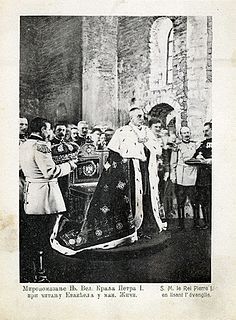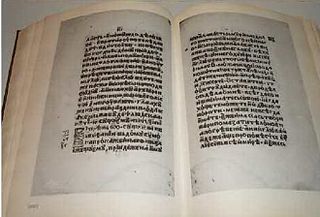 W
WThe Serbian Orthodox Church is one of the autocephalous Eastern Orthodox Christian churches. It is the second-oldest Slavic Orthodox Church in the world.
 W
WThe Belgrade printing house was a printing house established by count Radiša Dmitrović in Belgrade, Ottoman Serbia. It was the first printing house in Belgrade. After Dmitrović's death, the printing house was taken over by Trojan Gundulić, who organized publishing of the first and only book of this printing house, the Gospel, printed and edited in 1552 by Hieromonk Mardarije.
 W
WThe Building of the Patriarchate is a building in Belgrade, the capital of Serbia. It is the administrative seat of the Serbian Orthodox Church and its head, the Patriarch of the Serbian Orthodox Church. Finished in 1935, the building was declared a cultural monument on 18 December 1984.
 W
WWhen the Serbs in Banat rose up against the Ottomans in 1594, using the portrait of Saint Sava on their war flags, the Ottomans retaliated by incinerating the relics of St. Sava on the Vračar plateau in Belgrade. Grand Vizier Koca Sinan Pasha, the main commander of the Ottoman army, ordered for the relics to be brought from Mileševa to Belgrade, where he set them on fire on 27 April. Monk Nićifor of the Fenek monastery wrote that "there was great violence carried out against the clergy and devastation of monasteries". The Ottomans sought to symbolically and really, set fire to the Serb determination of freedom, which had become growingly noticeable. The event, however, sparked an increase in rebel activity, until the suppression of the uprising in 1595. It is believed that his left hand was saved; it is currently held at Mileševa.
 W
WArsenije III Crnojević was the Archbishop of Peć and Serbian Patriarch from 1674 to his death in 1706. In 1689, during the Habsburg-Ottoman War (1683-1699), he sided with Habsburgs, upon their temporary occupation of Serbia. In 1690, he left the Patriarchal Monastery of Peć and led the Great Migration of Serbs from Ottoman Serbia into the Habsburg Monarchy. There he received three charters, granted to him by Emperor Leopold I, securing religious and ecclesiastical autonomy of Eastern Orthodoxy in the Habsburg Monarchy. In the meanwhile, after restoring their rule in Serbian lands, Ottomans allowed the appointment of a new Serbian Patriarch, Kalinik I (1691-1710), thus creating a jurisdictional division within the Serbian Orthodox Church. Until death, in 1706, Patriarch Arsenije remained the head of Serbian Orthodox Church in Habsburg lands, laying foundations for the creation of an autonomous ecclesiastical province, later known as the Metropolitanate of Karlovci.
 W
WCharter of Ravanica was the founding charter of the Ravanica monastery, the main endowment (ktetor), and burial place of Prince Lazar of Serbia, issued in 1381.
 W
WThe accession of the Serbian monarch was legitimized by coronation ceremony. The coronation was carried out by church officials.
 W
WDeclaratory Rescript of the Illyrian Nation was issued on 16 July 1779 by Maria Theresa, Dowager-Empress and Queen of Hungary (1740-1780). It was a royal rescript, issued in response to a series of petitions made by Eastern Orthodox subjects of the Habsburg Monarchy, regarding the regulation of their religious freedom and ecclesiastical autonomy. The document was the result of a process, initiated by previously issued Regulamentum privilegiorum (1770) and Regulamentum Illyricae Nationis (1777), both of them replaced by the royal rescript of 1779.
 W
WEparchy of Mileševa is the one of eparchies of the Serbian Orthodox Church, and is seated in Prijepolje, in the Mileševa monastery.
 W
WEparchy of Žiča is one of the eparchies of the Serbian Orthodox Church in the Republic of Serbia. It is seated in Kraljevo, in the Monastery of Žiča. Since 2014, diocesan bishop is Justin Stefanović.
 W
WThe Goražde printing house was one of the earliest printing houses among the Serbs, and the first in the territory of present-day Bosnia and Herzegovina. Established in 1519 in Venice, it was soon relocated to the Serbian Orthodox Church of Saint George in the village of Sopotnica near Goražde, in the Ottoman Sanjak of Herzegovina. It was founded and run by Božidar Ljubavić, also known as Božidar Goraždanin, who was a prominent merchant from Goražde. His son Teodor Ljubavić, a hieromonk of the Mileševa Monastery, managed the work of the printing house. It worked until 1523, producing three books, which are counted among the better accomplishments of early Serb printers.
 W
WHvosno was a medieval Serbian county located in the northern part of the Metohija region, in what is today Kosovo. It roughly encompassed the areas of the modern Istok and Peć municipalities. It was surrounded by the counties of Jelci to the north; Budimlja and Plav to the west; Zatrnava to the south; Draškovina and Podrimlje to the east and southeast.
 W
WJovan Kantul, sometimes numbered Jovan II was the Archbishop of Peć and Serbian Patriarch, the spiritual leader of the Serbian Orthodox Church, from 1592 until his death in 1614. He planned a major revolt in the Ottoman Balkans, with Grdan, the vojvoda of Nikšić, asking the pope for aid. Owing to his activities for planning a Serbian revolt, he was arrested and put on trial in Istanbul in 1612. He was found guilty of treason and was executed two years later (1614).
 W
WThe Karyes Typikon was written for the Karyes cell on Mount Athos in 1199 by Saint Sava, at the time a monk and later the first Serbian Archbishop. It is basically a translation from a standard Greek ascetic typikon with some minor changes. It became a model for Serbian solitary or eremitical monasticism also outside of Mount Athos. It is published along with the Catalog of Cyrillic manuscripts from the Hilandar monastery since 1908.
 W
WThe Life of St. Sava was the second biography of Saint Sava (1169–1236), the first Archbishop of Serbs, written by Serbian monk Teodosije the Hilandarian (1246–1328), after the first biography written in 1254 by monk Domentijan.
 W
WThe Metropolitanate of Belgrade was a metropolitanate of the Serbian Orthodox Church which existed between 1831 and 1920, with jurisdiction over the territory of Principality and Kingdom of Serbia. It was formed in 1831, when the Ecumenical Patriarchate of Constantinople granted church autonomy to the Principality of Serbia. Territorial enlargement and full canonical autocephaly were gained in 1879. The Metropolitanate of Belgrade existed until 1920, when it was merged with Patriarchate of Karlovci and other Serbian ecclesiastical provinces to form the united Serbian Orthodox Church. The seat of the Metropolitanate was in Belgrade, Serbia.
 W
WThe Metropolitanate of Karlovci was a metropolitanate of the Serbian Orthodox Church that existed between 1708 and 1848 (1920). Between 1708 and 1713 it was known as the Metropolitanate of Krušedol, and between 1713 and 1848 as the Metropolitanate of Karlovci. In 1848, it was transformed into the Patriarchate of Karlovci, which existed until 1920, when it was merged with Metropolitanate of Belgrade and other Serbian church provinces to form the united Serbian Orthodox Church.
 W
WThe Mileševa printing house was a printing house established in 1544 in the Mileševa monastery near Prijepolje, Ottoman Empire. Three srbulje books were printed in this printing house. Two in 1544 and 1545 and one in 1557.
 W
WThe Mrkšina crkva printing house was a printing house established in 1562 in the Monastery of Mrkšina Crkva in village Kosjerić in Ottoman Serbia. This printing house was operational until 1566 and printed two srbulje books, The Four Gospels (Четворојеванђеље) in 1562 and The Flower Triod in 1566. In 1567 the Ottomans destroyed the church and its printing house.
 W
WThe Patriarchate Court is a listed historical building which was the seat of the Patriarchate of Karlovci between 1848 and 1920, in Sremski Karlovci, Serbia.
 W
WThe Patriarchate of Karlovci or Serbian Patriarchate of Sremski Karlovci, was a patriarchate of the Serbian Orthodox Church which existed between 1848 and 1920. It was formed in 1848, when the Metropolitanate of Karlovci was elevated to the rank of patriarchate. The Patriarchate of Karlovci existed until 1920, when it was merged with Metropolitanate of Belgrade and other Serbian ecclesiastical provinces to form the united Serbian Orthodox Church. The seat of the Patriarchate was in Karlovci.
 W
WThe Rujno Monastery printing house was a printing house established in 1537 in the Monastery of Saint George in village Vrutci of Rujno Župa near Užice, Ottoman Empire. The monastery had substantial income from its nearby spa so it established the printing house. Still, this income was insufficient for metal types. That is why hieromonk Teodosije, hegumen of the monastery, and his fellow monks, made types of 250 engraved wooden plates. They printed one book in this printing house, The Rujan Four Gospels. The Ottomans burned monastery together with its printing house to prevent further printing of books. Since 1984 the remnants of this monastery are below Lake Vrutci.
 W
WArsenije IV Jovanović Šakabenta was the Archbishop of Peć and Serbian Patriarch from 1725 to 1737 and Head of the Serbian Orthodox Church in Habsburg Monarchy from 1737 to his death in 1748.
 W
WThe Serb uprising of 1596–1597, also known as the Herzegovina uprising of 1596–1597, was a rebellion organized by Serbian Patriarch Jovan Kantul and led by Grdan, the vojvoda ("duke") of Nikšić against the Ottomans in the Sanjak of Herzegovina and Montenegro Vilayet, during the Long Turkish War (1593–1606). The uprising broke out in the aftermath of the failed Banat Uprising in 1594 and the burning of Saint Sava's relics on April 27, 1595; it included the tribes of Bjelopavlići, Drobnjaci, Nikšić, and Piva. The rebels, defeated at the field of Gacko in 1597, were forced to capitulate due to a lack of foreign support.
 W
WThe Serbian Patriarchate of Peć or just Patriarchate of Peć, was an autocephalous Eastern Orthodox Patriarchate that existed from 1346 to 1766 with its seat in the Patriarchal Monastery of Peć. It had ecclesiastical jurisdiction over Eastern Orthodox Christians in Serbian Lands and other western regions of Southeastern Europe. Primates of the Patriarchate were styled Archbishop of Peć and Serbian Patriarch.
 W
WThe Serbian national awakening or Serbian Revival refers to a period in the history of the Serbs between the 18th century and the de jure establishment of the Principality of Serbia (1878). It began in Habsburg territory, in Sremski Karlovci. The Serbian renaissance is said to have begun in 17th-century Banat. The Serbian Revival began earlier than the Bulgarian National Revival. The first revolt in the Ottoman Empire to acquire a national character was the Serbian Revolution (1804–1817), which was the culmination of the Serbian renaissance. According to Jelena Milojković-Djurić: "The first literary and learned society among the Slavs was Matica srpska, founded by the leaders of Serbian revival in Pest in 1826." Vojvodina became the cradle of the Serbian renaissance during the 19th century. Vuk Stefanović Karadžić (1787–1864) was the most instrumental in this period.
 W
WThe St. Stephen Chrysobull or Banjska Chrysobull was a chrysobull, charter, issued in 1314–16 by Serbian king Stefan Milutin. It was held at the Banjska monastery founded by Milutin. It is currently held at the Topkapi library in Istanbul.
 W
WBogorodica Trojeručica or simply Trojeručica is a famous wonderworking icon in the Serbian Orthodox monastery of Hilandar on Mount Athos, Greece. It depicts Theotokos with young Jesus in the hodegetria position, and is covered with a riza. It is the most important icon of the Serbian Orthodox Church. On the back of the icon is the painting of St Nicholas.
 W
WThe Nomocanon of Saint Sava, known in Serbian as Zakonopravilo (Законоправило) or Krmčija (Крмчија), was the highest code in the Serbian Orthodox Church, finished in 1219. This legal act was written in simple folk language and its basic purpose was to organize continuation and functioning of the Serbian kingdom and the Serbian church. It was originally printed under the name „Rules of Speech“ in the language of Raška, in two issues, one for Vlaška and another one for Erdelja in 1640.